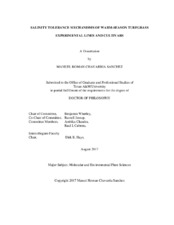| dc.description.abstract | Growth and physiological mechanisms of select experimental lines were chosen genotypes of warm-season turfgrass species bermudagrass (C. dactylon sp), zoysiagrass (Z. matrella sp and Z japonica sp), St. Augustinegrass (Stenotraphrum secundatum), and Seashore paspalum (Paspalum vaginatum) were studied. Greenhouse screenings were conducted during 2014 and 2015 at Texas A&M University, College Station TX to determine relative salinity tolerance among species under four salinity levels: 0, 15, 30 and 45 dS m-1. Based on these initial screening studies, in 2015, the best-performing entry of each species was examined following exposure to two levels of salinity (0 and 30 dS m-1) using scanning electron microscopy and energy dispersive spectroscopy to elucidate morphological/ anatomical attributes related to salinity tolerance mechanisms.
In 2016, eight entries (2 entries per species representing the highest and lowest-performing lines for relative salinity tolerance) were advanced for further evaluation aimed at determining physiological responses to salinity. Grasses were grown in the greenhouse over 10 weeks at salinity levels of 0, 15, and 30 dS m-1. Ion excretion efficiency, Na and Cl concentrations, and root and shoot tissue Na:K were evaluated to determine relationships with previously observed differences in salinity tolerance/intolerance. Collectively, the data support the notion that salinity tolerant genotypes employ one or more physiological mechanisms including salt excretion, root exclusion, limitation of Na and/or Cl transport to shoots, and maintenance of ion balance in coping with saline conditions. | en |


